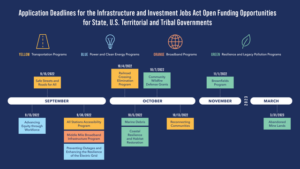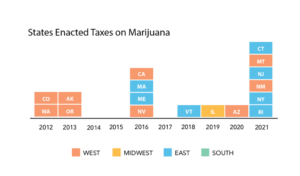By Blair Lozier
On July 13, the American Rescue Plan Workforce Summit took place on behalf of Vice President Kamala Harris, the White House American Rescue Plan Implementation Team and the White House Office on Intergovernmental Affairs. The summit addressed key areas of infrastructure that were funded through the American Rescue Plan Act including public health, infrastructure and expanding the workforce. Here are some of the highlighted examples of state and local governments putting American Rescue Plan dollars to work from the summit:
Perspectives from the States
The American Rescue Plan allocated $350 billion for state, local, territorial and tribal governments. Within the $350 billion, $195 billion was allocated directly to state governments. With the historic amount of funds given to states, the summit highlighted two states that are making a difference by using the funding for transformational change.
North Carolina Gov. Roy Cooper was able to maximize the delivery of health care by utilizing the increased the Federal Medical Assistance Percentage and implementing the Medicaid expansion provisions available from the Biden administration.Pennsylvania Gov. Tom Wolfe discussed the efforts to transform the post-secondary education system within his state.
Infrastructure Jobs focus on Pre-Apprenticeships
The Bipartisan Infrastructure Law distributes $550 billion in a federal program mostly dedicated to states and localities. States and cities presented innovative ways that they have been distributing the American Rescue Plan dollars to create jobs and skilled workers for building infrastructure through pre-apprenticeships.
North America’s Building Trade Union highlighted a pre-apprentice model developed for Building Trades Academy in the Baltimore–Washington, D.C., area. The apprentice program provides guided access into the building trade, they partner with local counsel, state and community-based organizations to end barriers and attract individuals to the workforce.Franklin County, Ohio, developed the Building Futures Program. This 12-week program is to get individuals ready for a career in construction.Los Angeles County, California, created the High Roads Training partnerships to Build Back Equity. This partnership invests in career opportunities, launches a worker equity fund, supplies intensive case management, and removes barriers to success in underserved populations.In Kentucky, Louisville Mayor Greg Fischer presented Kentuckiana Works. This program is designed to help individuals with training for skilled workers. Washington, D.C., Mayor Muriel Bowser is funding an Infrastructure Academy. The Infrastructure Academy is for high-impact job areas with good compensation to eliminate the housing crisis within the D.C. area.
Care and Public Health Workforce
The America Rescue Plan also had a focus on funds for care infrastructure, which includes child care, public health, health care and elderly care. Service Employees International Union Secretary April Verrett mentioned the importance of elderly care, “All 50 states applied for home care dollars.” The Caregiver Initiative is all about investing in care and enabling caregivers the pay they deserve.
Ramsey County, Minnesota, distributed every penny of its American Rescue Plan funds for transformation and foundation work in The Early Childhood Academy and Career Pathways program. The Early Childhood Academy aims are eliminating barriers in child care. Career Pathways program supply training for health care professions.The Erie County, New York, Health Care Careers Grant provides training for health care occupations that are in high demand.FAST Programs were developed in Manchester, New Hampshire, to encourage community building. The intended purpose is to reduce unintended emergency calls, supply the proper level of care in situations and empower the community to work together by becoming community health workers.Community RISE Programs are developed to promote health care education to underserved populations. The program is funded through the U.S. Department of Health and Human Services throughout the U.S. and territories.
Expanding Access to the Workforce for Underserved Populations
States are using the American Rescue Plan to end barriers to gaining employment. Here are some examples:
In Milwaukee, Wisconsin, WRTP Big Step is an apprenticeship to supply sustainable jobs by removing lead pipes. Employ Milwaukee aids individuals with employment, the goal is to get people out of the low-income/poverty cycle. Harris County, Texas, developed Employ to Empower where individuals can aid individuals experiencing homelessness by gaining work, career readiness and other resources that give a helping hand.Opportunity Memphis focuses on R3: rethinking, rebuilding and rebranding individuals between 16-24 looking for workforce readiness in Memphis, Tennessee.




